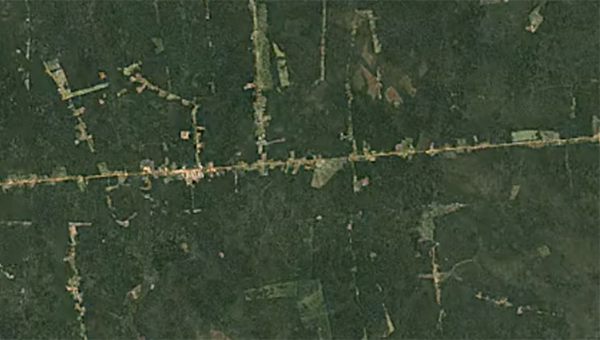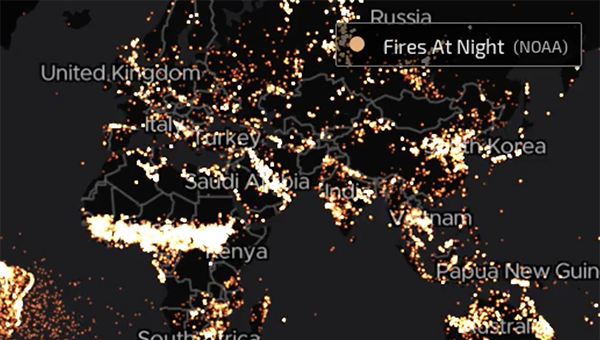Data Tells a Global Story to Influence Policy
By Scottie Barsotti
It’s the kind of problem solving you can only find at Carnegie Mellon University. CMU’s CREATE Lab fused data and technology to develop EarthTime, an open-source tool that tells visually striking stories of global change.
The visuals can provoke awe and wonder, but also horror. They can be inspiring and amazing, but also overwhelming and bleak. To say “it puts things in perspective” would be an understatement.
The flow of goods post-globalization, streaming across the screen like cosmic dust. The rapid growth of urban centers, crittering out like a concrete spider’s web. Deforestation in the Tropics turning green land gray like a rapidly spreading rash. A quarter of Florida’s landmass—including all of Miami and Fort Lauderdale—and many Gulf Coast communities swallowed up by the inky void of sea level rise due to climate change.
These eyebrow-raising visuals are presented as “stories” using an open-source data tool called EarthTime. Developed by the CMU Robotics Institute’s Community Robotics, Education and Technology Empowerment (CREATE) Lab in cooperation with the World Economic Forum, EarthTime is a quintessentially CMU innovation that unleashes evocative new modes of data-driven storytelling.
Experts often describe problems by citing percentages, dollar amounts, and probabilities. While quantitative measures are absolutely fundamental to CMU, EarthTime goes one step further and enables researchers to show the impacts of global-scale change in vivid animated and time-lapse visualizations.
The Impact of a Single Road
These images show rapid deforestation and farm development following the construction of a single road through a section of the Amazon rainforest.
Bright at Night
This animation shows agricultural, industrial, and natural fires visible from space.
Using large open-source data sets combined with imagery from NASA satellites, EarthTime allows us to practice a sort of time travel. We can not only plainly see the effects of human activity on the planet, we can also create graphic projections of what might happen in the coming decades if trends continue—this is especially relevant as researchers and policymakers grapple with the complex realities of climate change, migrant populations displaced by conflict, and many other global-scale problems.
In a piece published by the World Economic Forum, CREATE Lab director Illah Nourbakhsh wrote:
“Could world experts on nutrition, pandemics, climate change, deforestation, refugees demonstrate actual change over the last few decades with the help of massive spatio-temporal visualizations? The project marries together the fact-based narratives of experts with visually compelling images—ones that break through every language and culture barrier, forging common ground across diverse viewpoints, helping to create the sense of unity we need to have meaningful discourse about how to steward our future more meaningfully.”
As the field of Public Interest Technology grows, a storytelling tool like EarthTime will become even more valuable to practitioners who want to illustrate global trends.
In addition to becoming a fixture at the World Economic Forum’s annual meeting, EarthTime has been utilized everywhere from museums to TED Talks. But even beyond researchers, thought leaders, journalists and other professional storytellers, EarthTime could become a potent educational tool as well.
"We've hit the point now that we have so much data that we really need to look at how the public can better engage with it," said Paul Dille, a senior software developer at CREATE Lab, in a January interview. "If a social studies teacher in North Dakota can pull up EarthTime and say: 'Here are 10 things that fit my lesson plan,' that would be awesome."
The Broad Policy Impacts of a World’s Eye View
For Heinz College faculty and students, EarthTime is a treasure trove. Across broad policy areas—energy and the environment, public and population health, poverty and inequality, trade and immigration, urban development and smart cities, proliferation of AI and other technologies, and many other pressing issues—EarthTime can make invisible problems visible like never before. FROM SPACE.
Seriously, though. Even a casual observer could spend hours on EarthTime, soaking up stories and marveling at the scale of it all. But better yet, they can create stories of their own. For policy-minded individuals who want to change minds and solve problems, it’s a tremendously powerful tool.
That’s the beauty of open data, it lets everyone tell a story—even a story as big as the world.

